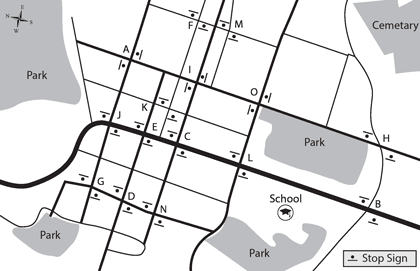This scenario is set in a small, rural town. The Roadway Manager in this community is responsible for approximately 50 miles of roads. About six months ago, a teenager died in a fatal car crash at an intersection in town. During the annual public works briefing regarding future road projects, one of the town commissioners asked if there are projects on the list that will improve intersection safety, or if there is a process for identifying sites that may need safety improvements. As an outcome of the discussion, the Roadway Manager was asked to develop an intersection safety plan to identify and prioritize safety improvements.
The intersection safety plan will document the evaluation of all 15 two-way stop-controlled intersections in town, identify intersections for detailed evaluation, diagnose conditions at these locations, and identify and prioritize countermeasures for implementation. Figure 2 is a schematic of the town roadway system and identifies all of the two-way stop-controlled intersections that will be evaluated.
Figure 2. Schematic of Town Roadway System

The Roadway Manager and staff have ample experience managing and maintaining the road system in their community. For studying this situation, they will:
- Compile crash reports from the police department;
- Conduct network screening;
- Select sites for investigation;
- Diagnose conditions and identify countermeasures using resources identified in the Toolkit;
- Conduct a benefit/cost analysis to prioritize countermeasures;
- Implement the selected treatment using guidance from national safety manuals presented in the Toolkit; and
- Evaluate the effectiveness of the implemented treatment.
